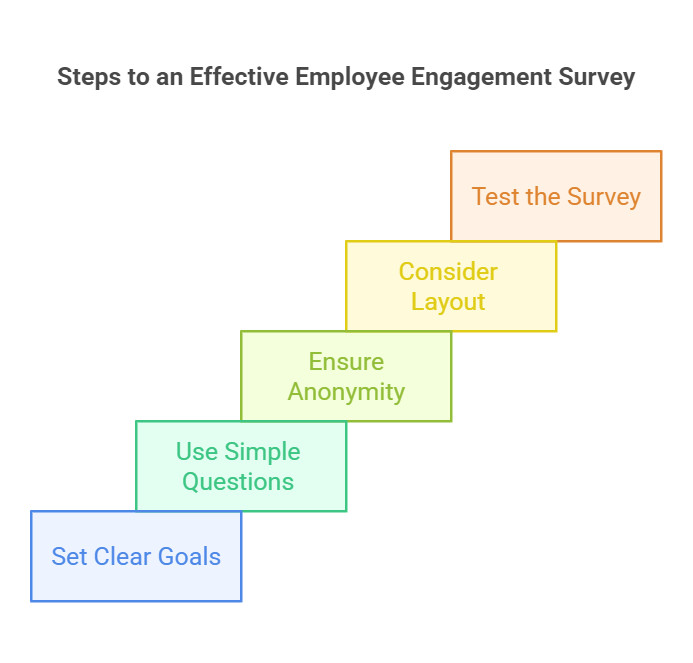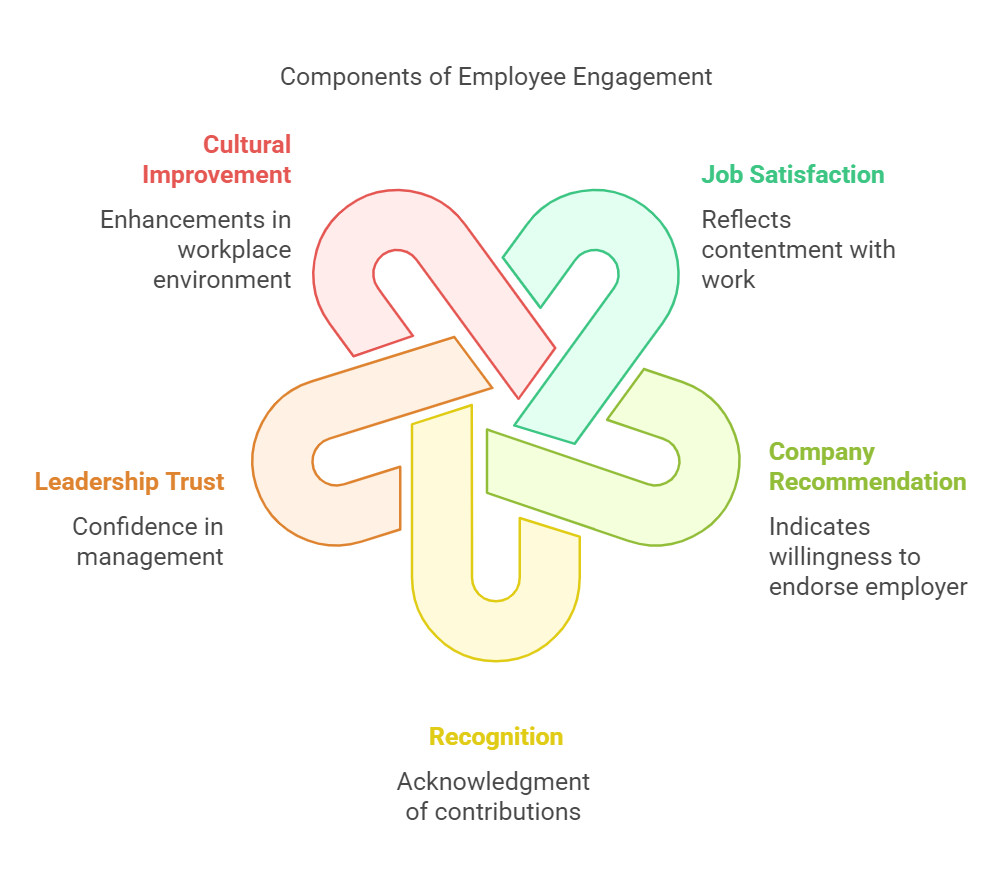- Research platform
Sources of information
Data analysis
Actions
- Solutions
For whom
Problems / Issues
- Materials
Materials
- About us
About us

In a competitive business world, an employee engagement survey helps to understand workplace morale. Understanding company culture is crucial as it directly impacts employee engagement and satisfaction. Conducting a survey is not enough; asking good questions is crucial for receiving honest insights from staff. This blog discusses creating questions that show employee feelings and promote openness.
If you want to find areas that need work, assess team spirit, or boost retention, this guide gives tools for effective employee engagement surveys. You will learn why survey design is important, what key metrics to consider, and ways to use feedback well. Also, we will share question examples that spark useful talks about engagement. Keep reading to see how to make surveys that turn insights into real strategies for a better workplace.
Employee engagement surveys are vital for understanding morale within teams and the overall employee experience. Engaged workers are more productive. They can show a 17% boost in productivity and 21% increase in profits. This shows the strong link between engagement and business performance.
These surveys give a way to measure and understand employee thoughts. They help find areas needing improvement and offer feedback about workplace practices. Employee sentiment can provide critical insights into employees' feelings about their work experience, enabling organizations to make informed decisions that enhance commitment and morale. For example, companies with regular engagement surveys find 58% more employees are highly engaged. This proactive method allows firms to find problems early on.
Conducting employee engagement surveys fosters open communication and trust, employees feel safe sharing opinions. This helps management make informed choices using real data, enhancing job satisfaction and lowering turnover rates.
Organizations valuing employee feedback show a commitment to well-being. This increases loyalty and retention. When staff are engaged, they stay longer thus lowering turnover costs.
In conclusion, using employee engagement surveys is key for firms wanting to improve work culture. It aids employee satisfaction and drives better business results. Better use of these surveys leads to services designed for specific employee issues, which elevate overall engagement.
Having understood the value of employee engagement surveys, let’s look at how to create effective surveys to achieve optimal outcomes.

Creating a effective employee engagement survey is vital for real feedback from staff. To gain meaningful insights, it's important to adhere to best practices that frame your survey. Here are key points to consider:
First, have clear goals before creating the survey. Knowing your desired outcomes helps craft your questions and gets relevant data. Whether measuring job satisfaction, pinpointing improvements, or assessing management, a focused strategy makes the survey easier.
Next, use short and clear questions to reduce confusion among those answering. Complicated wording can lead to misinterpretations, affecting data quality. Questions need to be simple and clear, allowing employees to answer without doubts.
It's key that respondents feel their answers are anonymous. When employees trust the confidentiality of their responses, they tend to be more candid. This safety encourages honest discussions about workplace matters, crucial for understanding staff opinions.
Additionally, think about the layout of the survey questions. Using both quantitative (e.g. Likert scales) and qualitative (e.g. open-ended questions) methods offers a fuller picture of engagement levels. Numbers help in analysis, but open comments reveal deeper feelings.
Finally, testing your survey with a small group prior to wide release can catch issues in clarity and structure. This feedback helps refine the survey for the larger workforce, enhancing response rates overall.
Next, we will cover what to measure in an employee engagement survey. This ensures you have the right metrics to effectively evaluate employee satisfaction.
When you conduct an employee engagement survey, it is important to measure both qualitative and quantitative factors. This approach gives organizations insights into employee sentiments and experiences, with a key aspect being measuring employee engagement. You will gather data that shows how engaged employees are.
Important areas to gauge in an employee engagement survey are job satisfaction, management relationships, and career growth. Knowing how workers feel about their roles and their chances for advancement can enhance the understanding of the workplace environment.
For example, data shows employees who feels valued by managers are 67% more engaged. This measuring aspect highlights the link between employees and management, which relates to employee performance and retention.
Additionally, job satisfaction levels are crucial to examine. Research shows companies with high job satisfaction have a 31% lower turnover rate. By asking questions about these feelings, organizations pinpoint areas that need help and support engagement.
Moreover, assessing opportunities for career growth lets employees state their professional development needs. Businesses promoting career growth see 20% higher employee engagement. Knowing employees’ aspirations help design programs that build skills and job satisfaction.
It is also important to assess learning and development opportunities as a critical factor for employee engagement and success. Access to necessary training, coaching, and support experiences is essential for employees to perform their jobs effectively.
Finally, measure how well employees’ values align with the organization’s as misalignment can cause disengagement. Employees in companies with aligned values report high job satisfaction and commitment. Identifying value-based questions that connect with your workforce gives insight into areas for boosting morale.
Having a clear idea of what to measure in an employee engagement survey helps you create relevant questions that reflect your organization. This focus gathers honest feedback and leads to actionable results that improve employee engagement.
As we move to the next section on crafting employee engagement survey questions, keep in mind that survey effectiveness depends on your ability to resonate measured components in your questions to gain genuine responses.
Constructing questions for an employee engagement survey needs clarity. Respondents must understand the questions well. Each question should be clear, avoiding jargon. This helps accuracy and response rates. Clear language is key.
Avoiding leading inquiries is important too. Leading questions can alter responses. For example, don’t ask, “How much do you love our benefits package?” Instead, ask, “How satisfied are you with our benefits package?” This way, employees can respond honestly.
Incorporating open-ended and close-ended questions helps gather feedback. Close-ended questions are easy to analyze. Open-ended ones let employees share thoughts. This mix offers a better view of experiences and perceptions.
It's also crucial to balance the frequency and length of surveys to avoid survey fatigue. Keeping surveys concise and manageable helps prevent overwhelming employees, ensuring valuable feedback is still gathered.
Spending time to create survey questions is necessary. Reliable feedback leads to better engagement strategies. Clarity, reduced bias, and varied question types improve insights from employee engagement survey.
After creating survey questions, focus on feedback collection. Gathering and using this info can build a more engaged workforce.
After crafting your employee engagement survey questions, the next step is to measure employee engagement as a key step in collecting and using the feedback effectively. Honest input from employees is just part of the work. The value is in how that feedback brings real change within the company.
It is crucial to regularly share results of employee engagement surveys with staff. This transparency builds trust and makes sure employees that their thoughts are heard. If employees know their feedback is shared openly, they are likely to feel comfortable participating in future surveys.
Additionally, acting on feedback is key. Showing to employees that their opinions matter can lift engagement levels. If staff raise issues about work-life balance, think about introducing flexible work schedules or extra support. Taking real steps based on survey results validates employee concerns and can boost morale overall.
Building a culture of openness is also vital in using collected feedback. When employees feel valued, they tend to share their ideas more. Companies that act on employee feedback often have better retention rates, as employees feel more tied to their workplace. Encouraging open conversations can uncover new solutions and improvements that may not have come up without the survey insights.
In conclusion, a commitment to transparency and acting on feedback can create a more engaged workforce. This sets the stage for the next step: selecting the right technology for surveys, which makes it easier to gather and analyze feedback.
Administering an employee engagement survey is just the first step in the process. To ensure the success of the survey and to maximize its impact, it’s essential to follow up with employees and take action on the feedback received.
Here are some best practices for survey administration and follow-up:
By following these best practices, organizations can ensure that their employee engagement surveys are effective and lead to meaningful change.
Conducting an employee engagement survey needs the right technology to impact data collection. A user-friendly platform boosts participation rates. Employees engage with surveys they find easy to reach and use. Investing in intuitive survey software leads to better, honest feedback.
Planning and communicating the next employee engagement survey is crucial to ensure its success. Thoughtful design and clear communication can significantly enhance employee engagement through the survey process.
Confidentiality of responses is also important. Keeping survey participants anonymous encourages candid feedback. Employees feel safe sharing true thoughts when their answers are anonymous. So, choosing software that provides this confidentiality is very important.
Today, a mobile-friendly survey technology is essential. Many employees work from phones or tablets, so easy access is crucial. Remote and in-field staff can take part easily, increasing the scope of data gathered. This adaptability raises participation and collects insights from a diverse workforce.
High data security standards in survey software protect sensitive info. It makes employees trust that their feedback stays private. With these factors in mind, organizations can build a smooth survey process that gains honest feedback, boosting employee engagement efforts.
Next, we will look at examples of effective employee engagement survey questions to improve how you gather feedback.

Creating an effective employee engagement survey relies on the questions asked. Good questions in employee surveys give insights into employees’ feelings and experiences. Here are some examples of effective employee engagement survey questions that encourage authentic feedback:
These questions help target areas that matter for employee engagement like job satisfaction and recognition. Organizations can gather useful insights to improve employee morale and productivity.
Studies show that satisfied employees are more productive. Satisfied employees can lead to 12% higher productivity than unsatisfied ones. Employees who recommend their company show a strong engagement level, helping retention rates.
Recognition is key. Around 75% of employees feel more engaged when their efforts are acknowledged. Trust in leadership is also important. High trust in managers leads to lower turnover and better satisfaction. Improvements in workplace culture can spark meaningful changes that resonate.
These questions guide organizations in the journey of employee engagement, fostering a satisfied workforce.
In conclusion, an employee engagement survey is vital for a thriving workplace. Understanding its significance and creating effective surveys offers insights into your team’s feelings and drives. Focus on selecting the correct measures and ask questions that encourage genuine feedback. This will be key for useful data.
It is essential to measure employee engagement through surveys to gather precise feedback. These surveys allow employees to express their opinions anonymously and serve as a basis for identifying issues and tracking changes in engagement levels over time.
Invest in proper technology for your surveys, which aids in streamlining and boosting participation. Looking at successful sample questions can help tailor your survey to match the unique culture of your workplace. Remember to keep in mind those strategies when making your employee engagement survey to gather precise feedback.
Now is the right moment to apply these ideas and build a survey that engages your employees and meets your goals. The effectiveness of your employee engagement survey is crucial for achieving positive workplace changes, leading to a motivated team. Welcome the experience of gathering real feedback to foster a positive influence within your organization!
Copyright © 2023. YourCX. All rights reserved — Design by Proformat